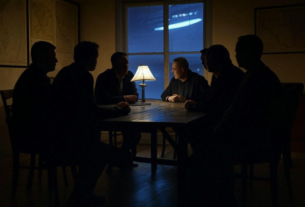In his biographical work Parallel Lives, the ancient historian Plutarch, who lived from approximately 46 to 120 AD, recounts a peculiar event that occurred in 74 BC during the Third Mithridatic War between the Roman general Lucius Licinius Lucullus and King Mithridates VI of Pontus. The incident took place in Phrygia, a region in modern-day Turkey near the Sakarya River, at a location called Otryae, just as the two armies were about to engage in battle. According to Plutarch, Lucullus commanded 30,000 infantry and 2,500 cavalry, while Mithridates’ forces, bolstered by a Roman defector named Marius sent by Sertorius from Spain, were significantly larger—rumored to number up to 300,000, though this figure may be exaggerated. Lucullus, daunted by the enemy’s size, initially hesitated to fight, but Marius challenged him, forcing him to prepare for combat.
As the armies faced off, with tension mounting for an imminent clash, Plutarch describes a sudden and dramatic phenomenon: with no prior change in weather, the sky abruptly “burst asunder,” and a huge, flame-like body fell between the two armies. He notes its shape as resembling a wine-jar—referred to as a pithos in Greek, a large storage vessel—and its color as being like molten silver. Both sides were so astonished by the sight that they withdrew, halting the battle before it could begin. This event, witnessed by thousands, including Lucullus and Mithridates, left a profound impression, interpreted by both as a divine omen.
The Third Mithridatic War, spanning 73 to 63 BC, was the final conflict between Rome and the Kingdom of Pontus, a Hellenistic state on the Black Sea coast of Anatolia. Mithridates, a formidable adversary known as “the Poison King” for his toxicology experiments, sought to resist Roman expansion, while Lucullus aimed to secure Rome’s dominance in the region. The incident at Otryae occurred early in the war, following Rome’s annexation of Bithynia, which prompted Mithridates to launch a preemptive campaign. The phenomenon’s timing—right before a pivotal battle—adds to its historical intrigue, as it temporarily spared both sides from bloodshed, though the war continued for years, eventually ending with Mithridates’ defeat by Pompey in 66 BC.
Plutarch’s account, written over a century later, relies on earlier sources, likely Roman military records or oral traditions, though he doesn’t specify them. The description of the object as a “flame-like body” resembling a silver wine-jar has led to various interpretations. Ancient peoples often viewed celestial events as divine signs, and both Lucullus and Mithridates, steeped in their respective cultural beliefs, likely saw it as such. Mithridates, whose life was marked by omens—comets reportedly heralded his birth and reign—might have interpreted it as a favorable sign from the gods, possibly linked to the Anatolian goddess Cybele, whose cult revered meteorites. Lucullus, aware of Cybele’s significance in Roman tradition after her sacred meteorite was brought to Rome in 204 BC, may have seen it as a protective sign, especially given his later success in the campaign.
Modern analyses lean toward a natural explanation. NASA astrophysicist Richard Stothers, in a 2007 paper on ancient UFOs, suggests the object was likely a bolide—a bright meteor that explodes in the atmosphere. The “molten silver” color aligns with the incandescence of a meteor during descent, though Stothers notes that freshly fallen meteorites are typically black, and Plutarch mentions no impact or sound, which is unusual for a meteorite of such size. The object’s estimated size—over four feet across to be visible to armies just beyond bowshot range—implies it would have been a significant find if it landed, yet no Phrygian records mention a recovered meteorite, despite the region’s tradition of meteorite worship. This absence challenges the meteorite theory, as does the lack of noise, which a bolide of that magnitude would typically produce.
Alternative theories include an atmospheric phenomenon like ball lightning, though such events rarely resemble structured objects like a wine-jar and lack the scale to be seen by thousands. Some UFO enthusiasts speculate it could indicate extraterrestrial intervention, citing its shape and sudden appearance as evidence of an alien craft, but this lacks supporting evidence and relies on modern interpretations of ancient texts. The most plausible explanation remains a celestial event, likely a meteor or bolide, misinterpreted through the lens of ancient superstition as a divine sign, a common practice in an era when omens heavily influenced military decisions.
The event’s impact on the battle was immediate—both armies retreated, delaying the confrontation. Lucullus later used strategic insight, interrogating captives to assess Mithridates’ supplies and predicting their imminent shortage, which allowed him to outmaneuver the larger force over time. The war dragged on, with Lucullus eventually replaced by Pompey, who delivered the final blow to Mithridates. The Otryae phenomenon, while not altering the war’s outcome, underscores how ancient societies integrated the unexplained into their worldview, shaping actions in ways that resonate with modern curiosity about the unknown.



